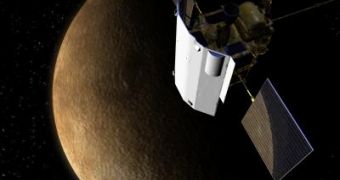On October 6, NASA's Messenger spacecraft will flyby Mercury for the fifth time in history. Equipped with $8.7 million worth of sensors, the probe will photograph most of the planet's surface, descending to an altitude of approximately 124 miles.
This will be the second time that Messenger passes by Mercury, and scientists from the Laboratory for Atmospheric and Space Physics (LASP) hope to get new ultra-violet images of the planet’s surface, in an attempt to determine what minerals it is made of.
The spacecraft, which will fly over the tiny rocky world for about 90 minutes, is relatively small, about the size of a desk, and contains 7 measurement instruments, including a camera, a magnetometer, an altimeter and several spectrometers. It has already circled the Sun several times since its launch in 2004, and will do so a few times more by 2009, when the third Mercury flyby is scheduled to take place. After that, the Messenger will attempt to enter and remain in a stable orbit above the planet, for more scientific observations.
Researchers at LASP hope that the ceramics layer covering the module is able to withstand the tremendous amounts of radiation, heat and other factors affecting it that close to the Sun. The Mercury Atmospheric and Surface Composition Spectrometer, or MASCS, will snap a series of shots during the mission, as astronomers hope to get a glimpse of the light reflected by the planet. This could give them possible explanations as to the reasons why particles separating themselves from Mercury's surface are accelerated in the 25,000-mile-long dust cloud that trails the planet on its orbit.
Messenger's first pass by Mercury took place on January 14, and provided LASP with important information about the changes the planet undergoes during daytime, when the Sun's influence is at its highest. The surface seems to be covered with high-temperature sodium gases, which are subjected to a sort of evaporation and acceleration process once hit by direct sunlight. They exit the atmosphere and enter the trail of the planet. By using MASCS, researchers hope to get a better understanding of how this works and why.
With another flyby and the entering in orbit scheduled for the next couple of years, LASP Senior Research Associate William McClintock says, "We are almost two-thirds of the way there, but we still have a lot of work to do." Indeed, scientists in the program have to constantly modify settings and parameters, in order to compensate for various external influences the probe is subject to.

 14 DAY TRIAL //
14 DAY TRIAL //